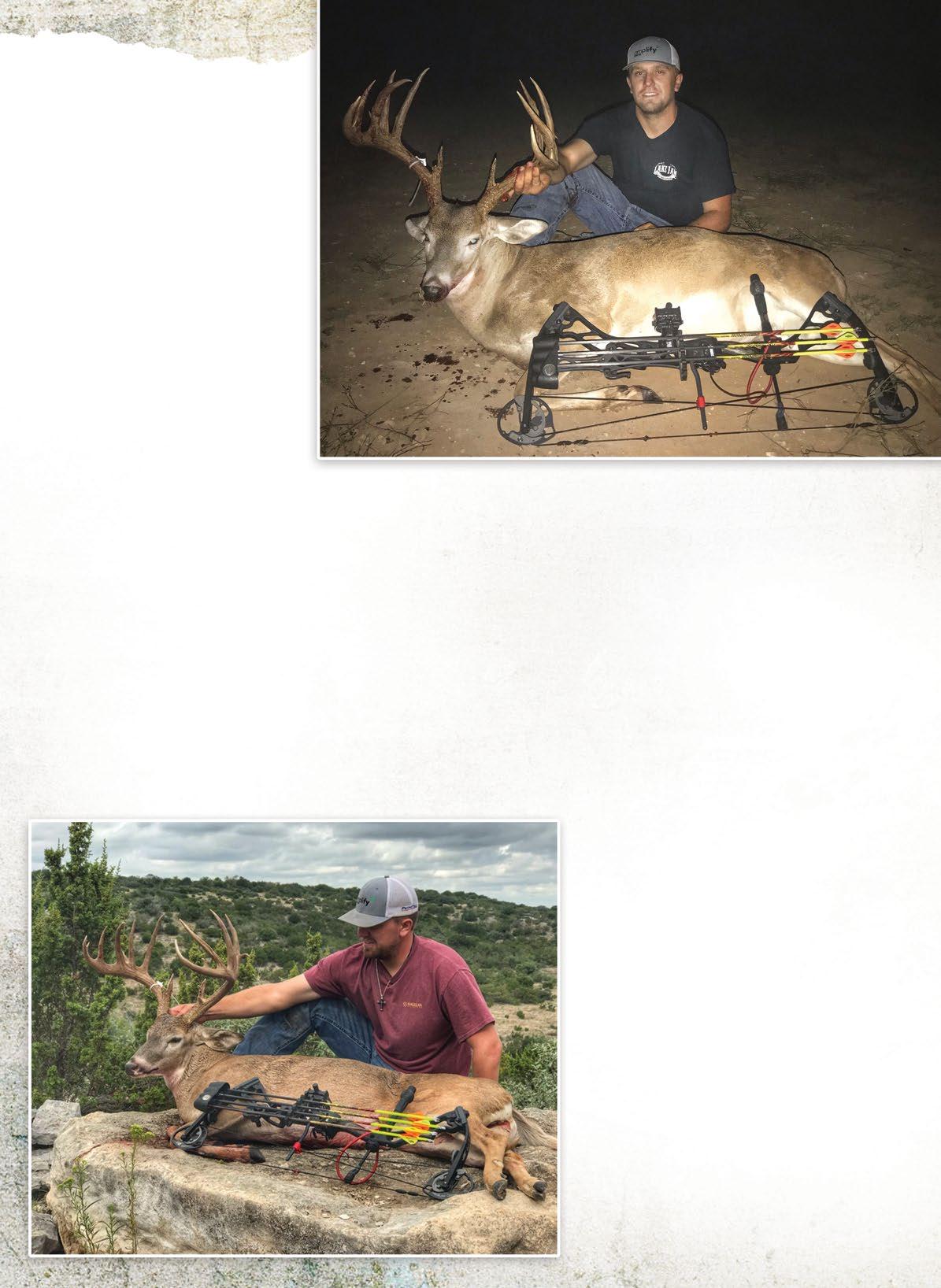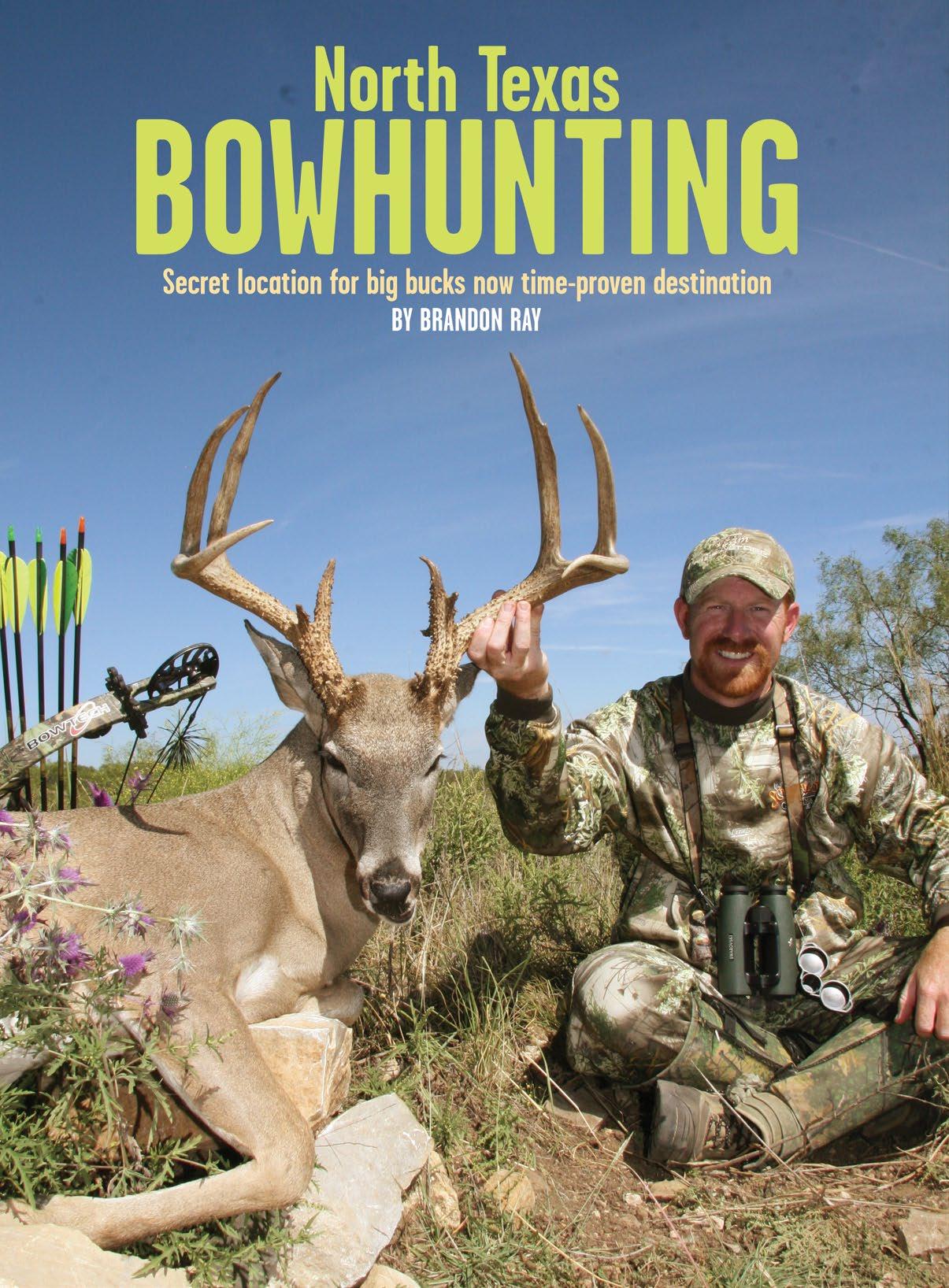
18 minute read
North Texas Bowhunting
Brandon with the 19-point non-typical mentioned in the opening paragraphs. The main-frame eight-point had 11 more scoreable points around the bases. He shot the buck in October 2007 in Shackelford County.
My friends dropped me at the pop-up blind well before dark. Instructions were as follows: “Ray, there’s a big eight-point that comes here. He’s old. I’ve only seen him from a distance, but he’s a good buck. If you see him, shoot him. Don’t shoot the young 10-point.” Taillights vanished into the mesquites and I waited on that October morning.
In the grey gloom just before shooting light, shapes of deer started to appear. One passed close, 10 yards from my blind. Even in the darkness I could see big antlers against the waking sky. I waited, barely breathing.
Finally, the sun was on the rise. Indeed, a mature eight-point buck stood there with three does. I could see good tine length, long beams and gnarly bases. I assumed this was the buck on the hit list. When he turned broadside at 30 yards, I took the shot.
The arrow was good, but there wasn’t much of a blood trail. On hands and knees, we searched until we found the buck stone dead in the knee-high broom weeds 200 yards away. What we thought was a 140-class eight-point turned into something more. The main-framed eight-point had another 11 extra points on his bases and brow tines, making him a 19-pointer! The mature whitetail ended up with a net non-typical score of 1575⁄8 Pope & Young.
That memorable hunt took place in 2007. The location was North Texas near the town of Albany in Shackelford County. The same property has produced even bigger bucks. On a neighboring property, one friend killed a typical 10-point that netted over Boone and Crockett’s 170-inch minimum. It’s no longer a secret that big whitetails can come from the northern half of the state.
Two similar, but slightly different ecological regions make up this northern-most area of Texas, the Rolling Plains and the High Plains. On average, deer numbers are lower here than say South Texas or the Hill Country. But mature bucks reach impressive size, both in antlers and body size. Here’s a closer look at these two regions.
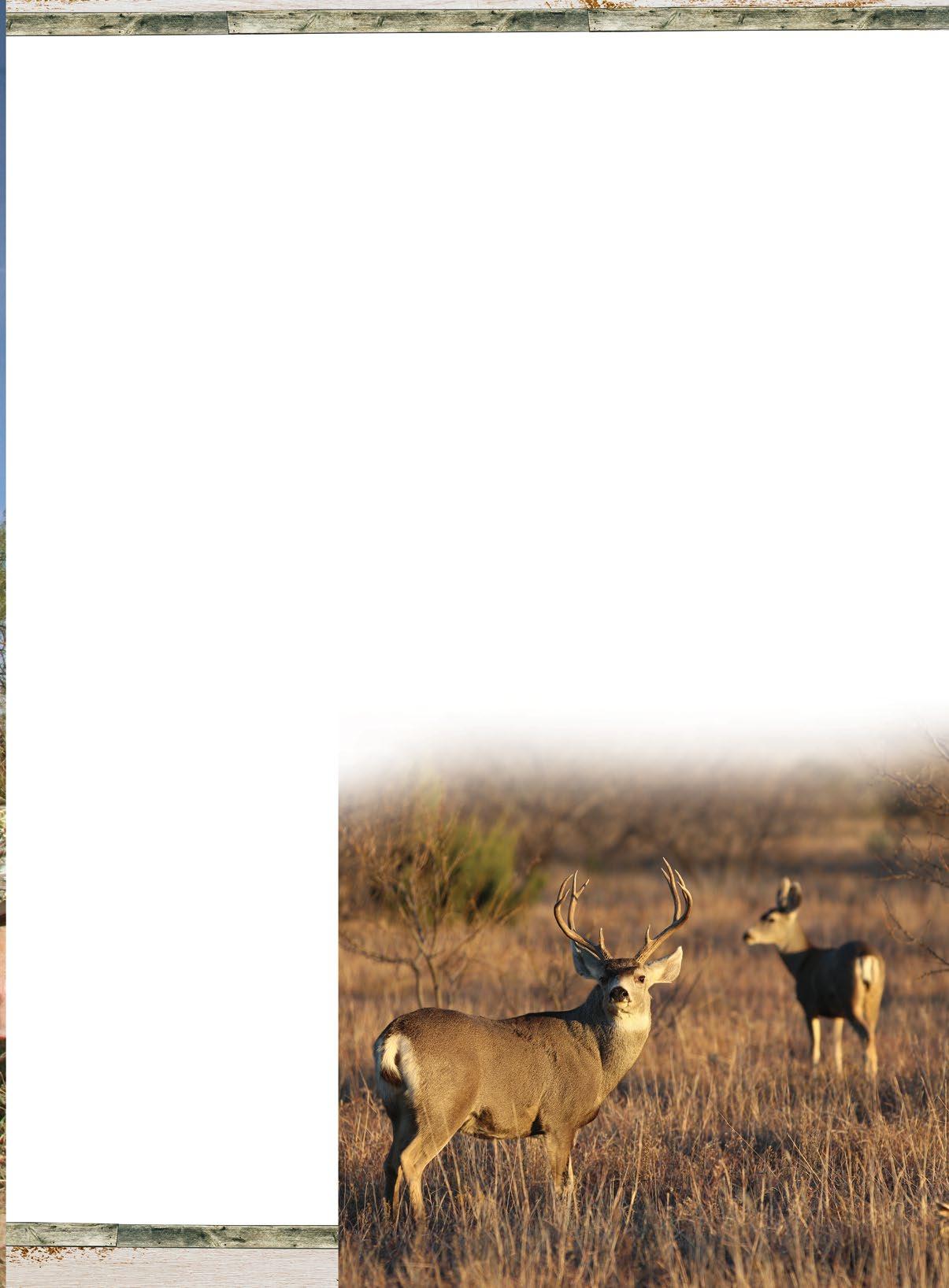
ROLLING PLAINS
The Rolling Plains is the ecological region roughly west of Fort Worth and going up the eastern counties in the Texas Panhandle. Like its name, the country has rolling hills, rivers that cut small canyons, and average annual rainfall from 20 to 28 inches. Elevations vary from 800 to 3,000 feet above sea level. Mesquites are common with shortgrass prairies and various hardwoods. Crop and livestock production are the major agricultural industries in this region.
Bow season starts in October. While warm weather can keep mature bucks nocturnal, that first and last hour of the day can be productive. The first week of the season, bucks are often still on a predictable summer pattern. Sometimes, bucks are still in summer bachelor herds.
Last fall, my friend Ronnie Parsons hunted a new place. On opening morning, he shot a giant, 150-class eight-point. The location was brushy mesquite flats in Borden County. The buck had been on a trail camera since early September, one of those rare older bucks that was very visible early in the season. Despite it being opening weekend, the mature buck already had a brow tine broken. Ronnie shot another impressive 140-class buck in a different Texas county later in the season. That makes an impressive 50 Pope & Young whitetails from Texas for Parsons.
A trail camera over a feeder or waterhole can pinpoint when to hunt. If bucks are moving only in the dark, stay out of the area. Be patient. Later in the month, monitor the weather. When storms come through and the temperature drops, those same bucks might start to move in daylight. That’s the window of opportunity you need. Plan your hunting time around those weather events. Year to year, I have the most encounters with mature bucks the last week in October and early November. The cooler weather patterns and the urges of the upcoming rut have bucks moving more in daylight.
Look for sign. Rubs will indicate where bucks are traveling. Last fall, a friend and I monitored a narrow strip of trees that ran down an old fence line in otherwise open terrain. This was just across the Texas border in the Oklahoma Panhandle. The strip of brush connected open fields to a nearby ravine. The deer were bedding in the ravine and CRP fields, then traveling down the fence to feed in the fields after dark. At least a dozen fresh rubs and several scrapes were in that 100-yard-long strip of cover, proof that more than one buck was likely traveling there. A trail camera proved one of the bucks was world-class, but only there in the dark. After several fruitless sits in October, my friend Shawn Hoover stayed out, waiting for the weather to change. On Nov. 2, the wind was right, and the temperature dropped. Shawn waited in his homemade hay bale blind. At sunset, the big, non-typical buck arrived. With one arrow at 20 yards, Shawn hit the buck with a double-lung shot. If not for a broken beam and a couple of broken points, that buck would
A mature 10-point mule deer in the Texas Panhandle. Both whitetails and mule deer can overlap in certain parts of the Rolling Plains and High Plains.
have scored 193 inches non-typical. Trail camera pictures proved the buck’s rack was fully intact just 24 hours earlier!
For peak rut action, North Texas biologists say hunt one week either side of Thanksgiving. Rattling and calling works because buck to doe ratios are often tight in low deer density counties. Last fall, on Nov. 20, I rattled late in the afternoon. I hid in a short tripod stand overlooking a Panhandle creek. After a short sequence of meshing two shed antlers together, I let out several grunts on my call. In less than five minutes, a buck came charging to the downwind side. I recognized him from earlier in the year, a middle-aged 10-point, but now he had two tines broken. He got a pass. He paced around at 30 yards looking for the fight, then dashed away.
Get a height advantage, a tripod or treestand if possible, so you can spot incoming bucks when rattling and calling. Watch the downwind side. Be prepared for a quick shot opportunity. Several years ago, I spotted a distant buck with his nose to the ground, cruising down a creek 200 yards away. Two short grunts on my grunt call perked the buck’s attention, then he came at me on a steady walk. I hesitated, having only one tag for that county, as the buck closed to 25 yards. He was a decent 130-class 10-point, but bigger bucks were around. When he hit the downwind side of me, he snorted and was gone. Calling is an excellent tactic if you spot a distant buck that likely won’t walk past your ambush point otherwise, so keep antlers and a call in your backpack.
HIGH PLAINS
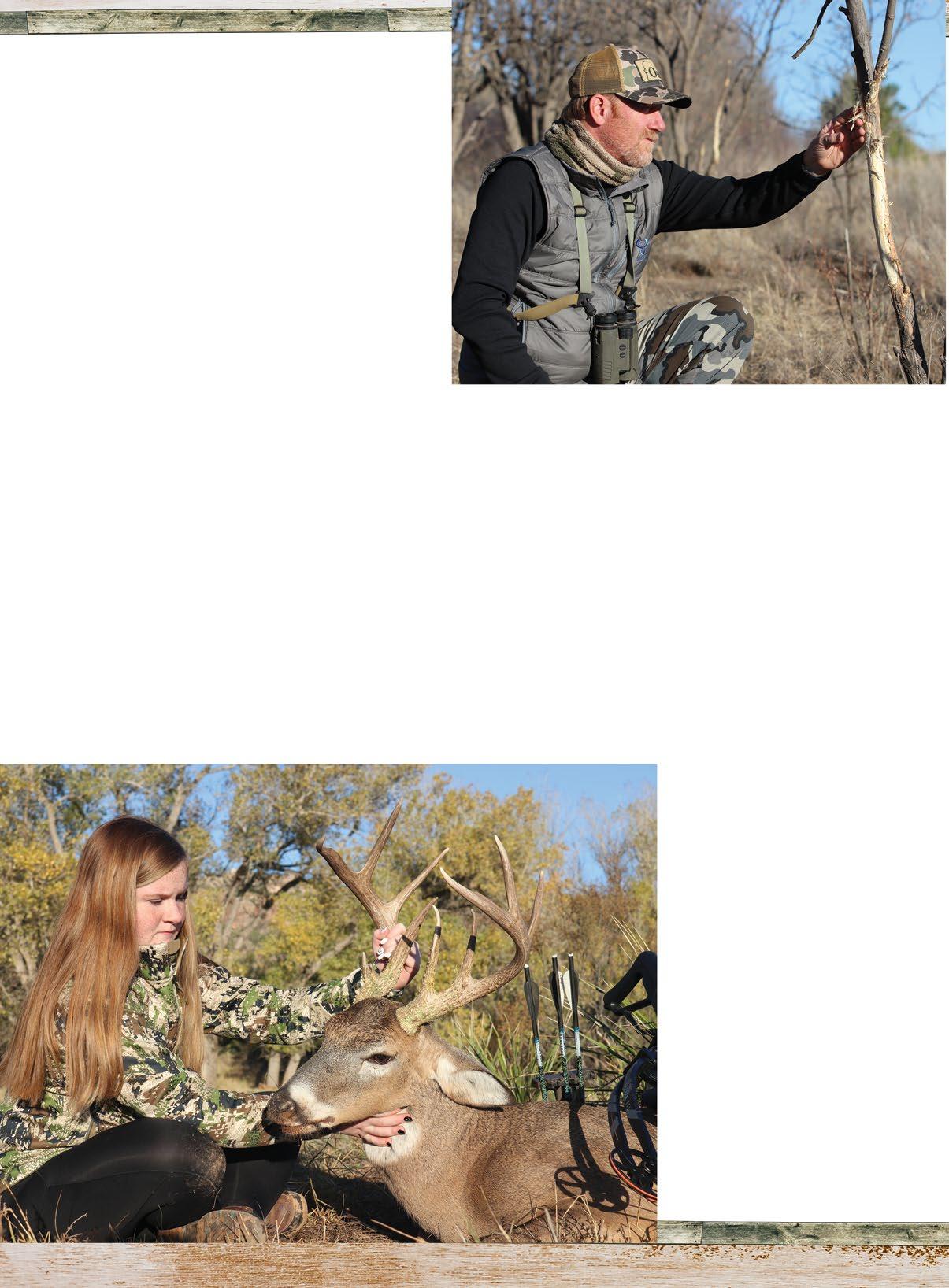
The High Plains is a relatively level high plateau, separated from the Rolling Plains by the Caprock Escarpment. It makes up the western-most counties of the lower and upper Texas Panhandle. Elevations range from 3,000 to 4,500 feet above sea level. Average annual rainfall is 15 to 22 inches. Although historically a grassland, mesquite and yucca have invaded parts of the region. Once this region was covered with immense herds of bison and pronghorn antelope. Today, the plains are mostly irrigated cropland, and the native vegetation includes more mesquite and juniper.
I remember a massive whitetail shed a friend discovered near crops while pheasant hunting. The one side scored 80 inches! My friends who farm near Dalhart find big bucks in and around crops. It’s difficult terrain to bowhunt, more conducive to spot-and-stalk because the deer are wanderers. Often times the best topography to bowhunt is an isolated creek with some brush and trees far from the crops. A windmill in arid country can also be an effective ambush point. Like whitetails anywhere else in Texas, corn feeders work to keep deer in the area. The absence of trees means ground blinds or short tripod stands work best.
Last fall, my daughter Emma and I waited in a natural brush blind built from cedar branches. A scenic creek with tall cottonwoods was nearby. It’s rough canyon country where the Rolling Plains and the High Plains converge. Deer numbers are modest, but we usually find a good buck on that creek every year. The early November morning was a cool 48 degrees. A small buck and two does appeared first. From the south came a bigger buck I’d never seen before. I gave Emma the nod to shoot when he turned. At 15 yards, Emma’s crossbow put a broadhead right through the buck’s heart. The fine buck had long brow tines and 11 total points. A fine buck for Emma’s first-ever whitetail. The High Plains is not only home to whitetails, but you also find mule deer. The big-eared bucks are often congregated around crop fields like wheat or milo. Nearby canyons with dense cedars serve as bedding and security cover. It was back in late October 2007 that bowhunter Jim Finch arrowed a giant non-typical in the northwestern Panhandle. That Hartley
The author examining a fresh rub. Notice more rubs in the background. Find a spot like this and bucks are obviously traveling through this patch of brush. A trail camera can tell you if the activity is nighttime or daytime.
Emma Ray with her first-ever whitetail. She shot the buck with her crossbow in November 2020 on a Panhandle creek. Dad was her guide. This hunt is described in the article.
County buck net-scored 2226⁄8 inches. It is still the largest non-typical mule deer from Texas in the Pope & Young Record Book. Panhandle counties that border eastern New Mexico produce a few whopper mule deer bucks every year. Mule deer can also be found on the eastern side of the Panhandle. The largest typical mule deer from Texas entered in the Pope & Young Record Book is from Cottle County. That 1857⁄8-inch buck was taken in 2004 by Johnathan Burpo. Proof that you don’t have to go to the Rocky Mountains to find a good mule deer buck.
In some of these top-of-Texas counties, the two deer species overlap. Mostly, the whitetails are in thicker, brushier, flatter terrain and the mule deer live in rougher, sometimes more open landscapes, but there are no hard rules on where you might find either one. I’ve had both species visit the same feeder. In my observations, the whitetails are more aggressive than the mule deer. I’ve seen white-tailed bucks chase and breed mule deer does, but never the reverse. In that area, I’ve seen two fawns I suspect were hybrids. Both fawns looked like a whitetail, but with a mule deer tail. And both had mule deer does as mothers. Ten years ago, I arrowed a fine 140-class whitetail from a ground blind. A week later, out of the same blind, I arrowed a 30-inch mule deer with a drop tine! Having both deer species on the same property certainly makes things interesting.
One early December afternoon, when both deer species were in season, I spotted bobbing antlers headed to a cedar-choked ravine. Binoculars proved it was a mule deer, not a whitetail. A careful stalk put me inside 20 yards of the unsuspecting mulie buck. The arrow found the ribs. Thirty minutes later, I found the 5½-year-old 10-point dead 125 yards away at the bottom of the yucca-dotted ravine. The handsome, grey-faced buck weighed over 200 pounds. The work started from there to get him back to the truck. It was an unexpected bonus on a day when scouting for whitetails was my priority. It’s not a secret any longer. North Texas is a proven destination for big bucks.
A well-concealed ground blind in the eastern Texas Panhandle.

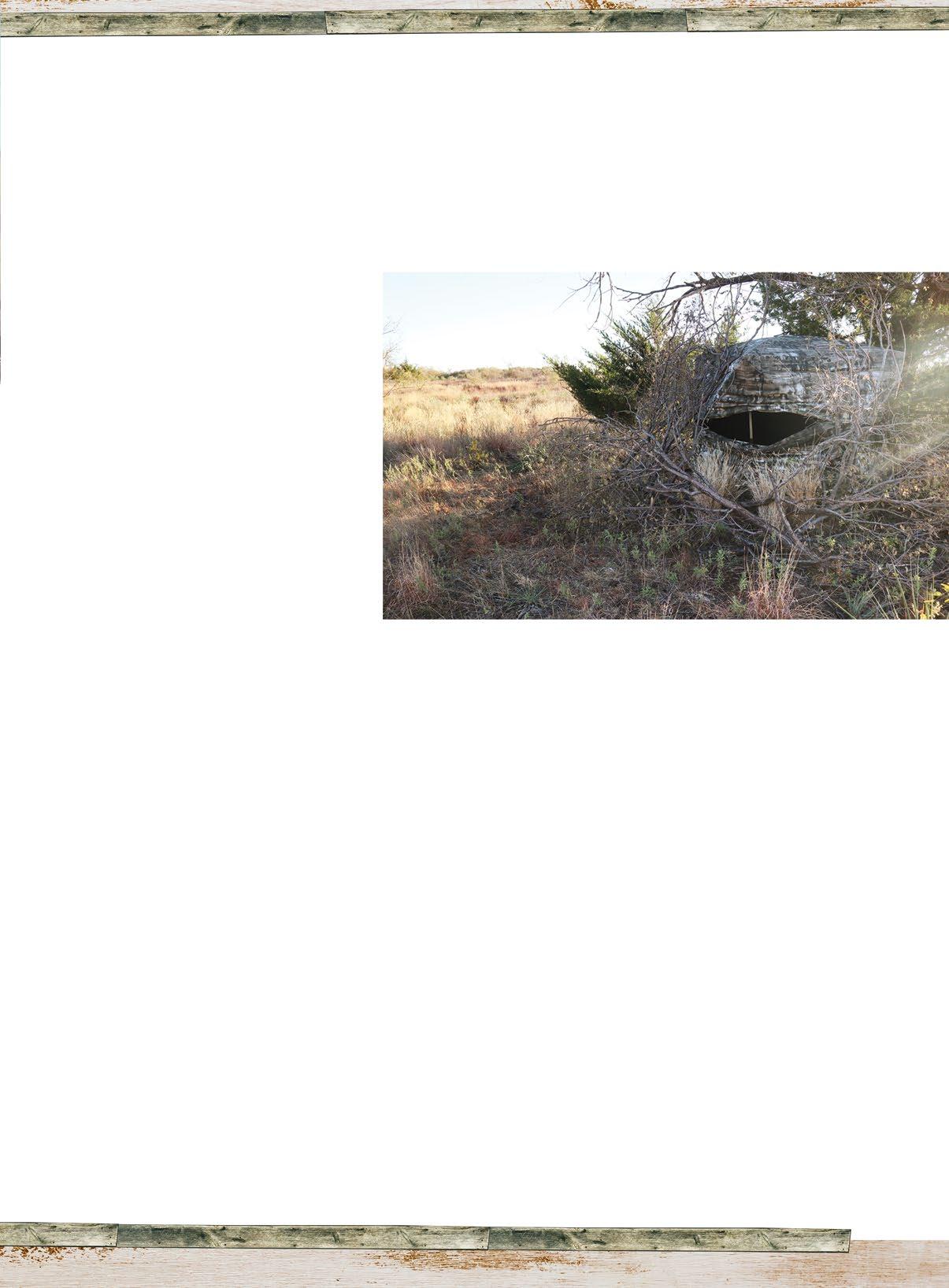
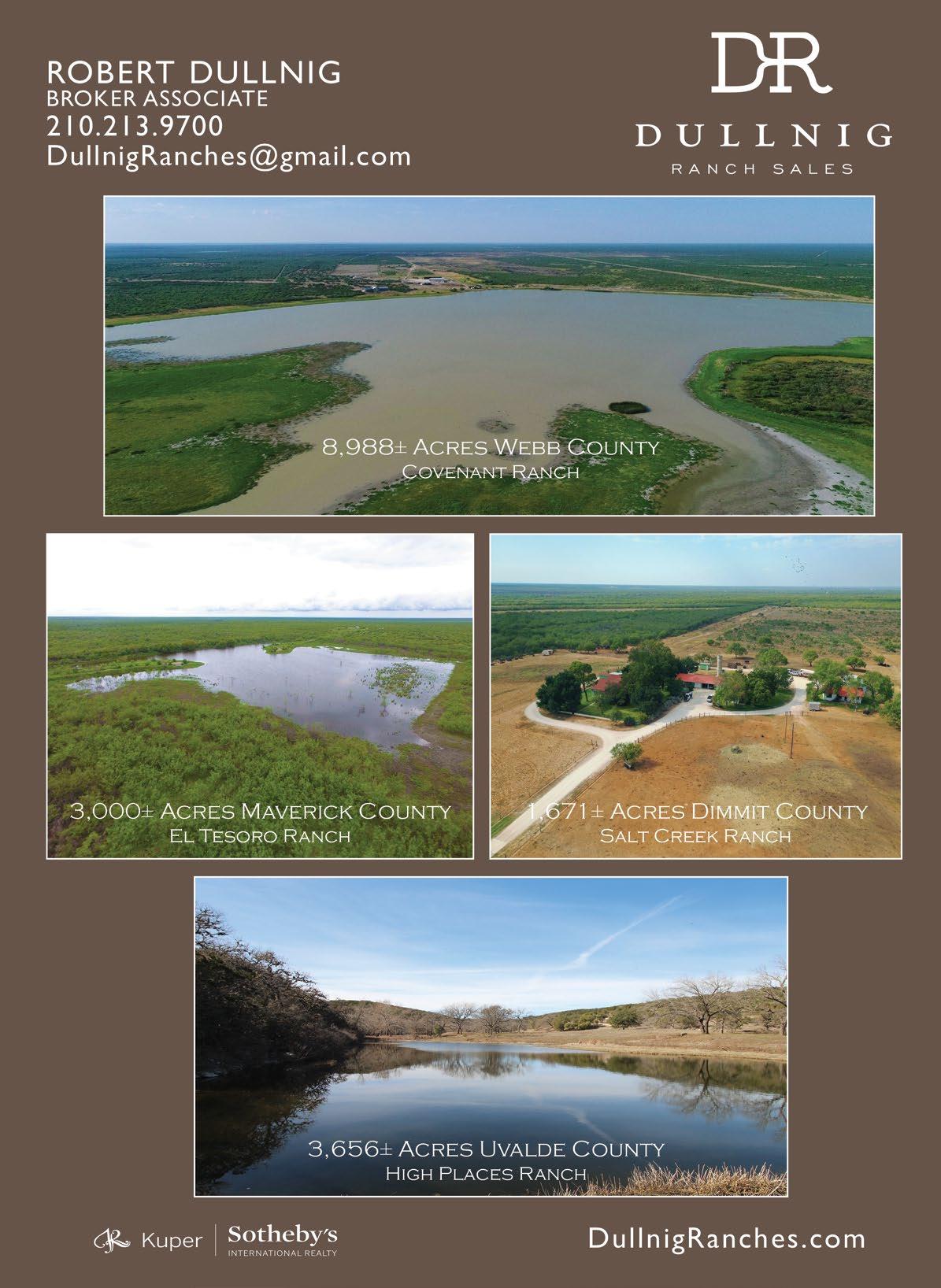
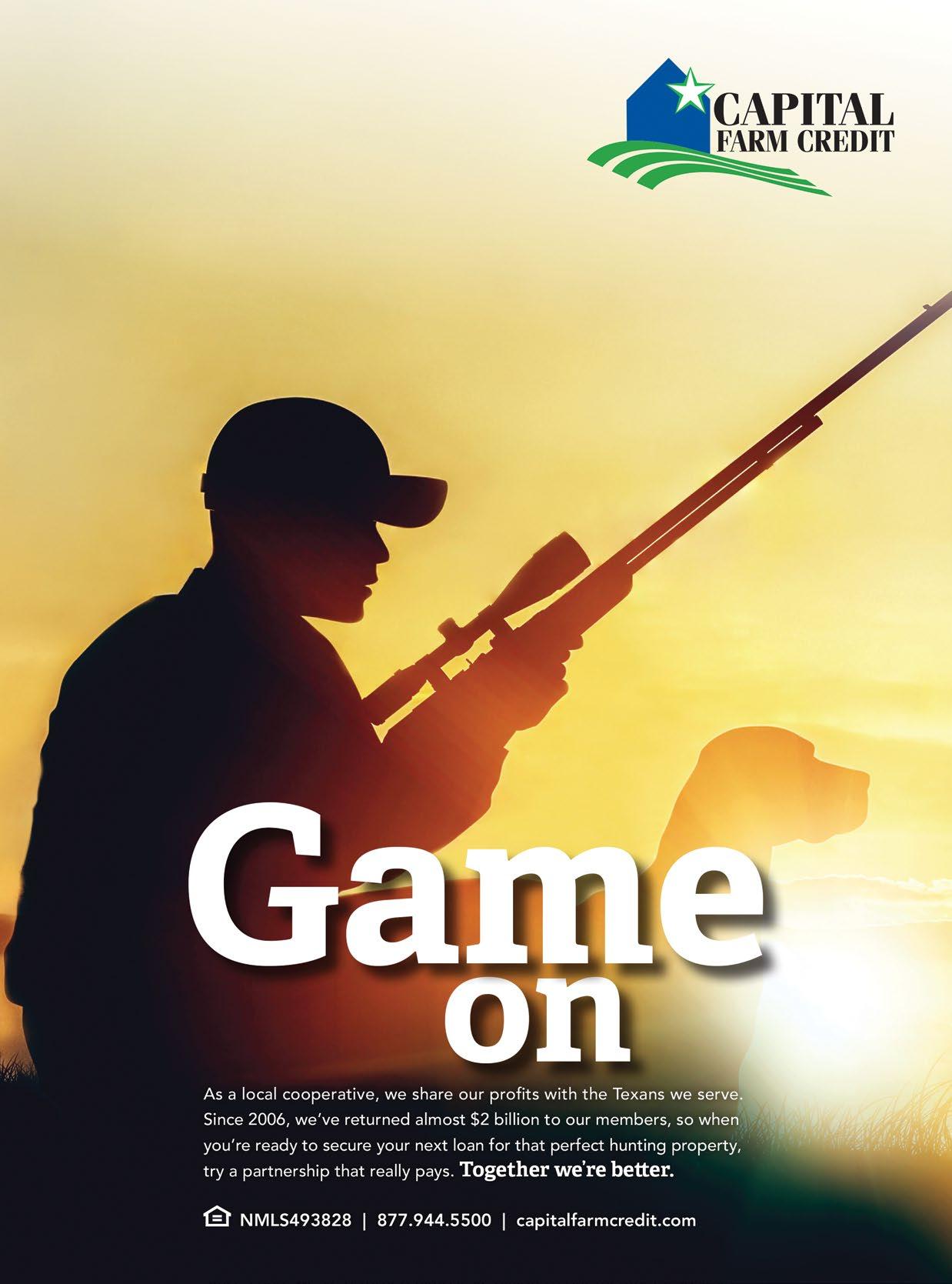
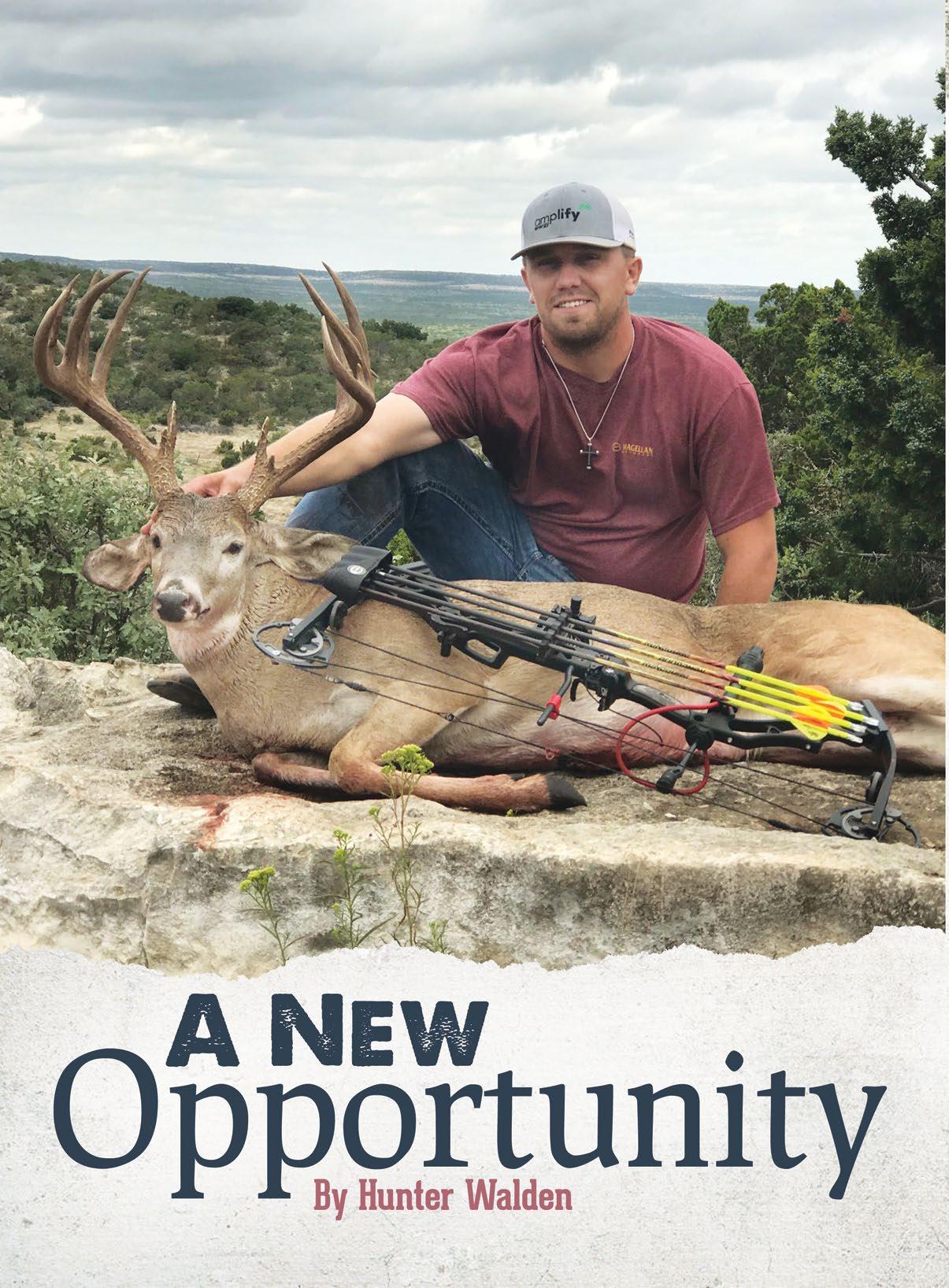
The author had to leave his previous lease behind and thought his run as a bowhunter would end. But a friend got him on another lease where he made a new start with this excellent trophy buck.
It all started in 2007. My stepdad asked if I would like to get on a lease outside San Angelo with him and some friends of ours. Of course, as any hunting fool would do, I jumped at the chance! Over the next 11 years, I made more hunting memories than I ever dreamed possible. I was 12 years old when I got on that lease, so I basically grew up hunting on it. There were years that were far better hunting-wise than other years, but it didn’t matter to me. Every trip I made out there and back home, all I could think about was getting back to the lease. That lease was very special to me. One of my good friends, Bo Willis, and I bowhunted the place for over 10 years.
In 2014 the landowner’s brother passed away, and he sold his half of the place. I was bummed. It was where my stand was, and where I thought I would hunt forever. Still a little bummed, I just kept telling myself, at least we still have some of the place. That summer I moved to the other half of the ranch that was staying in our landowner’s possession. Going into the spring of the 2018 season, things were slowly falling apart.
We went back and forth trying to come to an agreement, but nothing was ever reached. That was it. In February 2018 we notified them we would come get our stuff. I was disappointed. It was one of my favorite places on Earth and now I’d never see it again.
If I were to choose, I would have always hunted that ranch. I thought this might be the end of an era for me as a bowhunter. But looking back now, it’s funny how things worked out.
Going into the 2018 season, I started looking for new places in the area. I actually found a few good places with good people. But life happened. My wife and I were going to have a baby boy. I put the lease search on hold for the 2018 season.
Last spring, Jared Zoch messaged me and said they had an opening in Coke County, not 5 miles from where I had spent so many years hunting. After conversing back and forth about the place, I took the spot. It's in the same area I had hunted all those years, just a little way down the road. It was a huge relief to finally be back hunting in West Texas! I ended up getting my spot set up around the end of February, just in time to start the spring growing season. As the summer progressed, we easily saw we had some very special mature deer on the place.
The dog days of summer dragged by, but with each protein-work weekend that went by, the season inched closer. Around July or August, we really started pinpointing our bigger-end deer. For me, there were only two deer: a big giant freak of a West Texas buck, and a monster eight-point. That was all I needed to see.
I had made my mind up. I would take one of them, or nothing. I never had the big eight on my feeder, but I did see him at the water trough, just 200 yards or so from my blind. The other deer showed up at my feeder a few times, one time being in good daylight.
I also saw him at the water trough a few times. As September arrived, he was still on our lease fairly frequently. He would frequent a few feeders every so often, especially for rice bran. This deer was a traveler. He was hitting two different feeders over a mile apart. Going into opening weekend, I told most of the guys it was either him or bust. I had my heart set on hunting him.
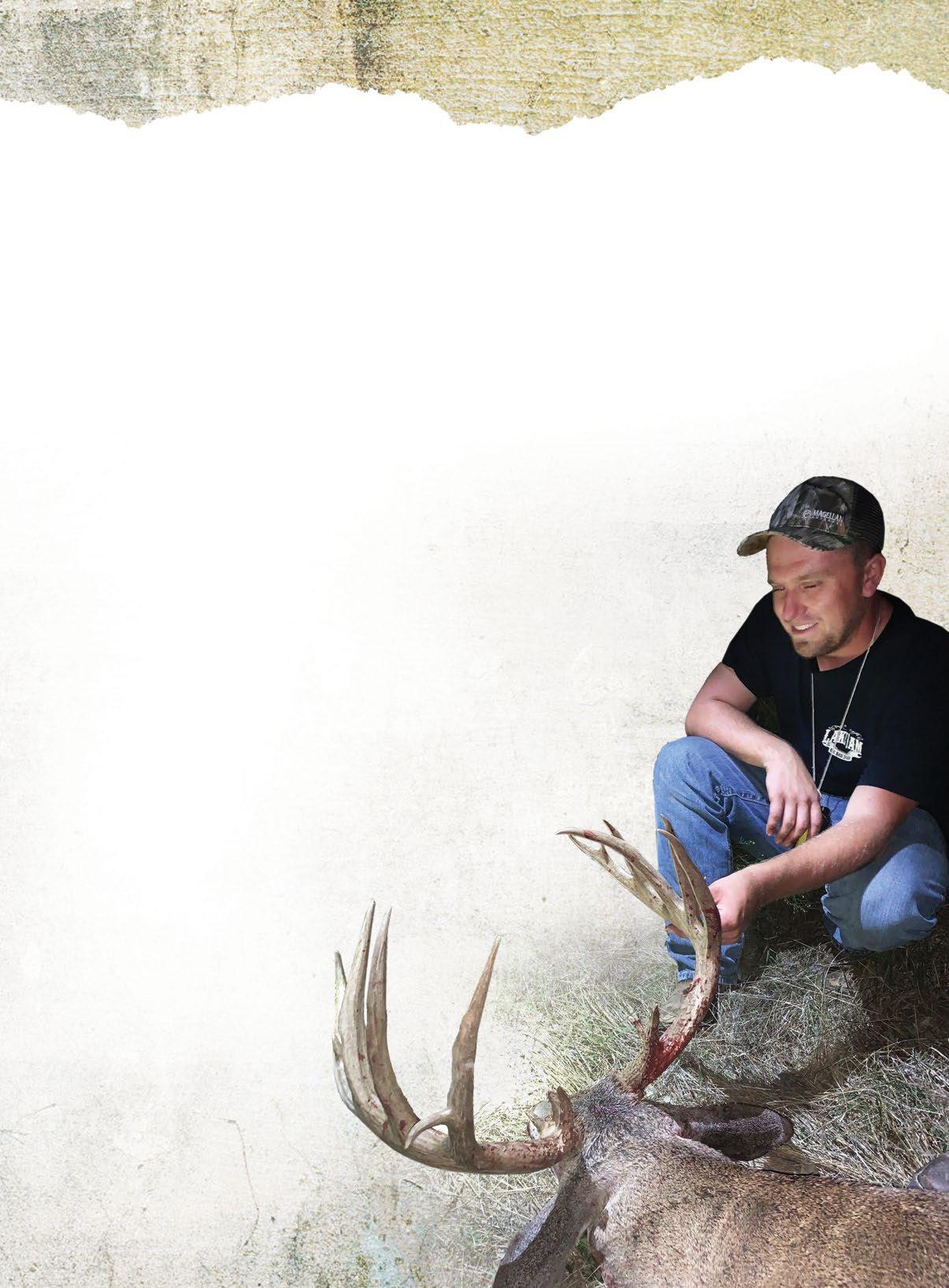
The Hunt
My dad and I arrived at camp Friday to hot temperatures and some overcast sky. I was fired up. We sat in the blind Saturday morning, messed around camp at midday, then I caught a pretty good nap. My good buddy, Daniel, actu-
As the author took aim at this buck, an eightpoint kept interfering with his shot. The author succeeded after the fourth attempt.
ally woke me up. I guess I had forgotten to set the alarm. I threw my clothes on as quickly as I could and got in the stand between 5:15 and 5:30.
It was hot. I talked to God for a good while, way longer than normal. It was “different” than all the times before. The afternoon had picked up right where the morning had left off. Deer came from every direction. Around 6, I had a pretty good sized eight-point come in and push most everything off the corn. He acted like it was late November and he was ready to go. At 6:15 when the feeder went off, I shut all the windows.
At 7:15 I heard a deer’s legs clip the feed pen around my protein feeder. I couldn’t see the protein feeder, but I didn’t think too much about it when none of the deer in front of me even acknowledged that other deer. I stuck my head to the edge of the blind to look, and there he was. I couldn’t believe it.
A much larger buck stood 20 yards from me and not one single deer even lifted its head. As he made his way in, I got my bow and readied myself for the shot. He came between me and the corn line. He was about 14 yards away when he stopped.
I got ready to draw and as I did, the eight-point turned around and postured up to the larger buck. He pinned his ears back and bristled up like he wanted a fight, but the larger buck left. He wanted no part of it and ran to my right, then out behind my feeder 40-50 yards away.
To my surprise the larger buck circled back around and came back to his original spot on the corn. I start getting ready for the shot only to have the eight do it again! The larger buck went out to 50 yards and stood there. He eventually circled back around to the same spot on the corn.
The third time was not the charm, because the eight did the same exact thing. He wanted the larger buck to have no part of his feeder. I could not believe what was happening, but the larger buck circled back in for a fourth and final time.
The larger buck was closer this time, and I actually drew before he got to the corn. But the eight came to push him off again! This time the larger buck turned the opposite direction and quartered towards me instead of directly away. I drew back on him and let the arrow fly and saw blood instantly.
He ran out to 20 yards, cut left, and when he did, blood sprayed out. I could see I got what looked to be about a foot of penetration. I thanked God for the opportunity at such an animal, and really started feeling good about the blood I saw.
After 45 minutes or so, I got down from the blind. I instantly found good lung blood. I decided to trail a little bit and just look for the arrow. I followed the blood down into the creek 30 yards or so from the feeder and was actually about to stop and back out, when I rounded the corner and found him. I could talk for hours trying to explain what I felt at that moment. I thanked God and headed to pick everyone up to enjoy this. I headed to camp to get my dad and some of the guys to go back and get my trophy. There were high fives, hugs and congratulations all around. It was a special night and a special weekend with as good of group of people as you could ask for. It just doesn’t get any better than that. I thank Jared for the opportunity to join such a great place. This being my first year on the lease, I did not have any prior history with this deer, but the rest of the lease did. They had seen him last year as a 130" 4-year-old. He exploded during the summer. The buck camp-scored 170" on the dot and had a live weight of 194 pounds. You just can’t beat Texas bowhunting!
